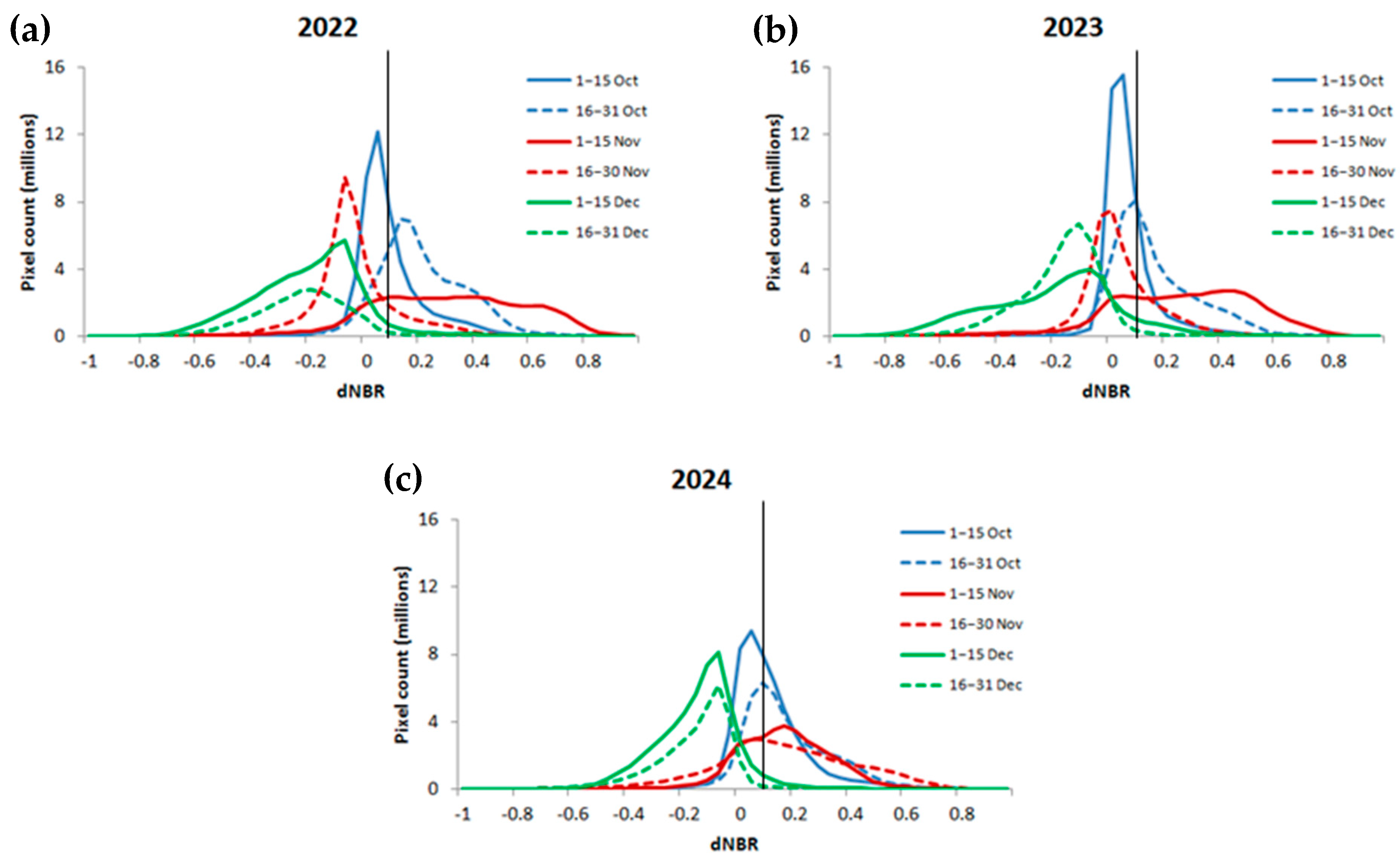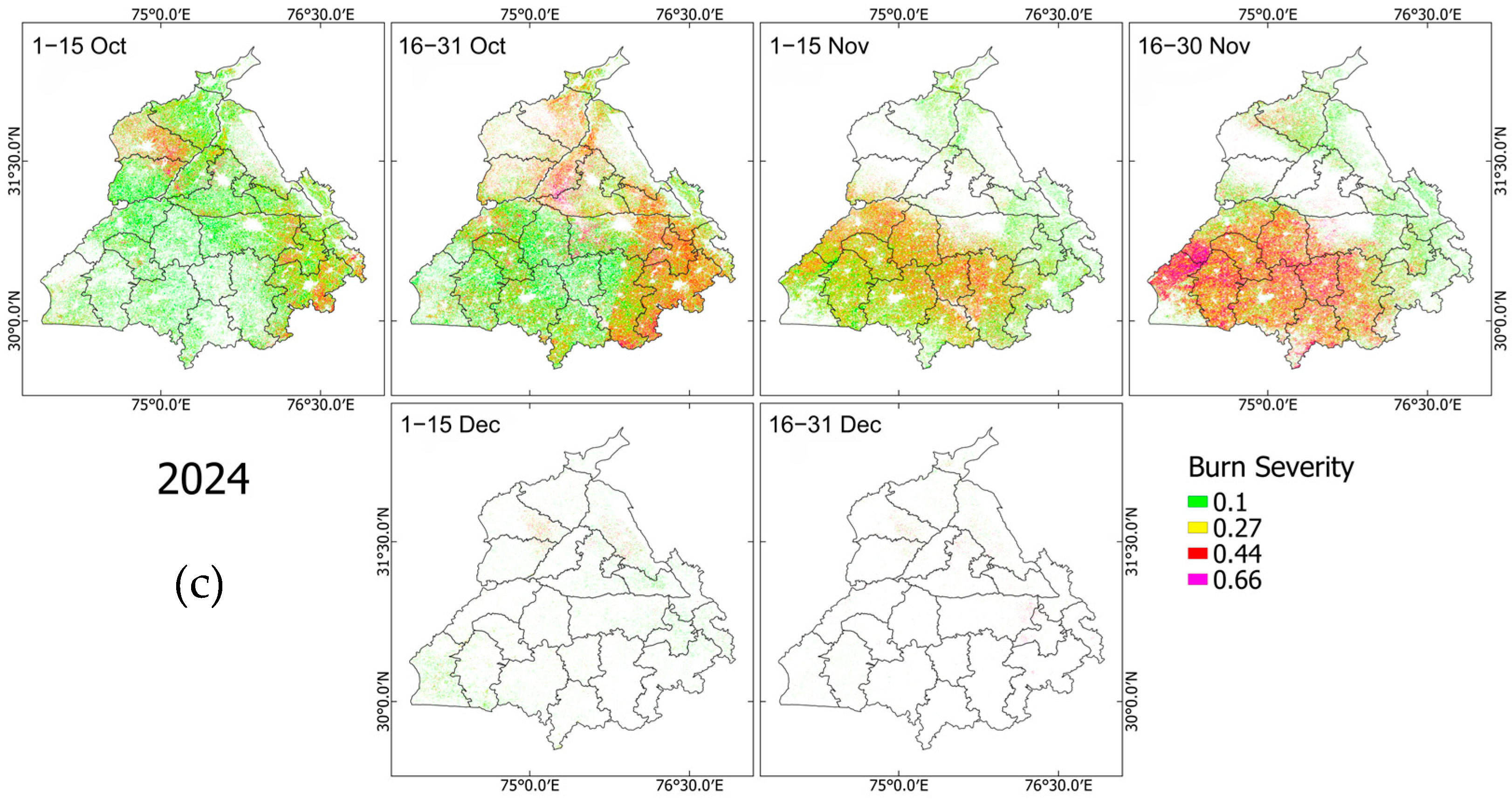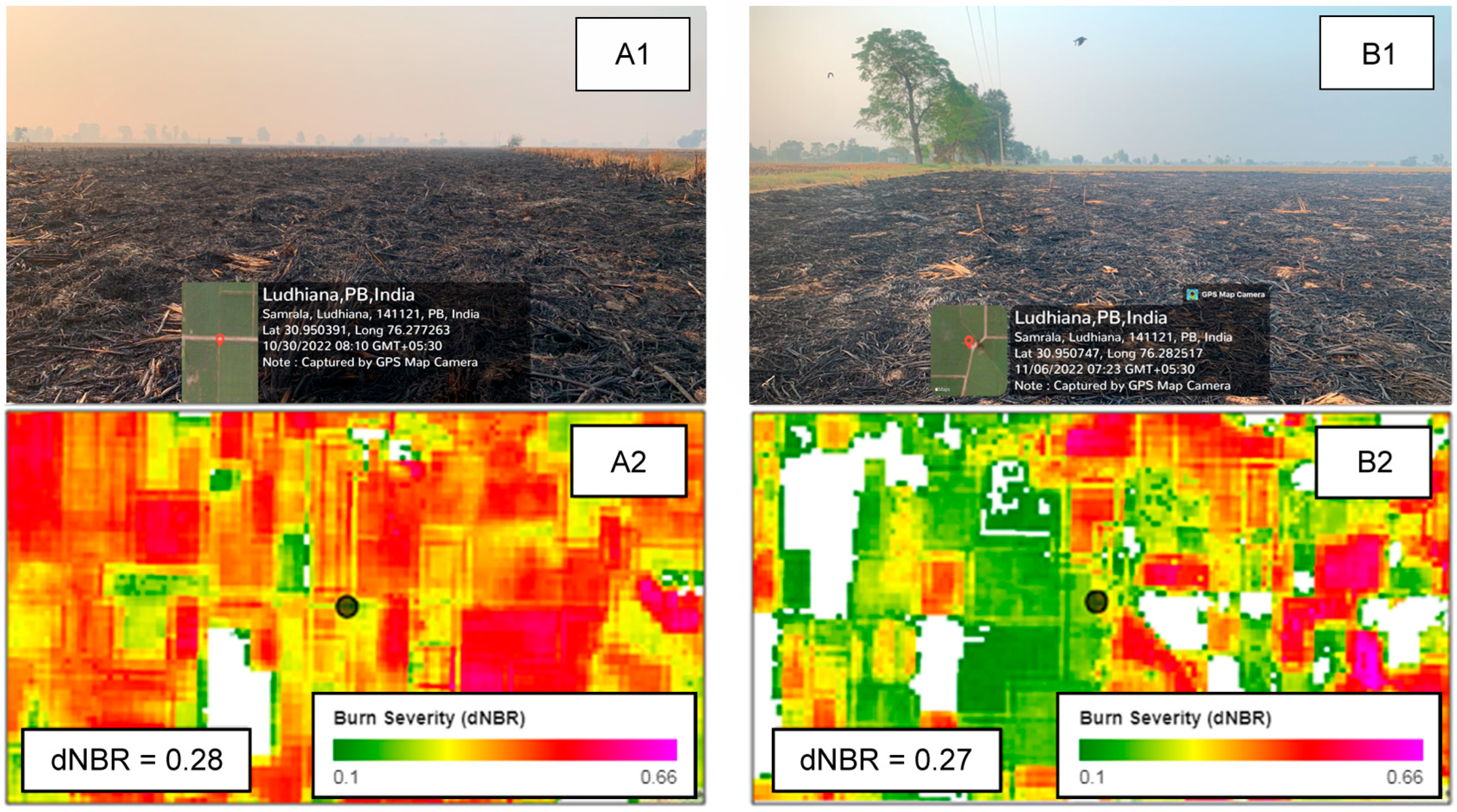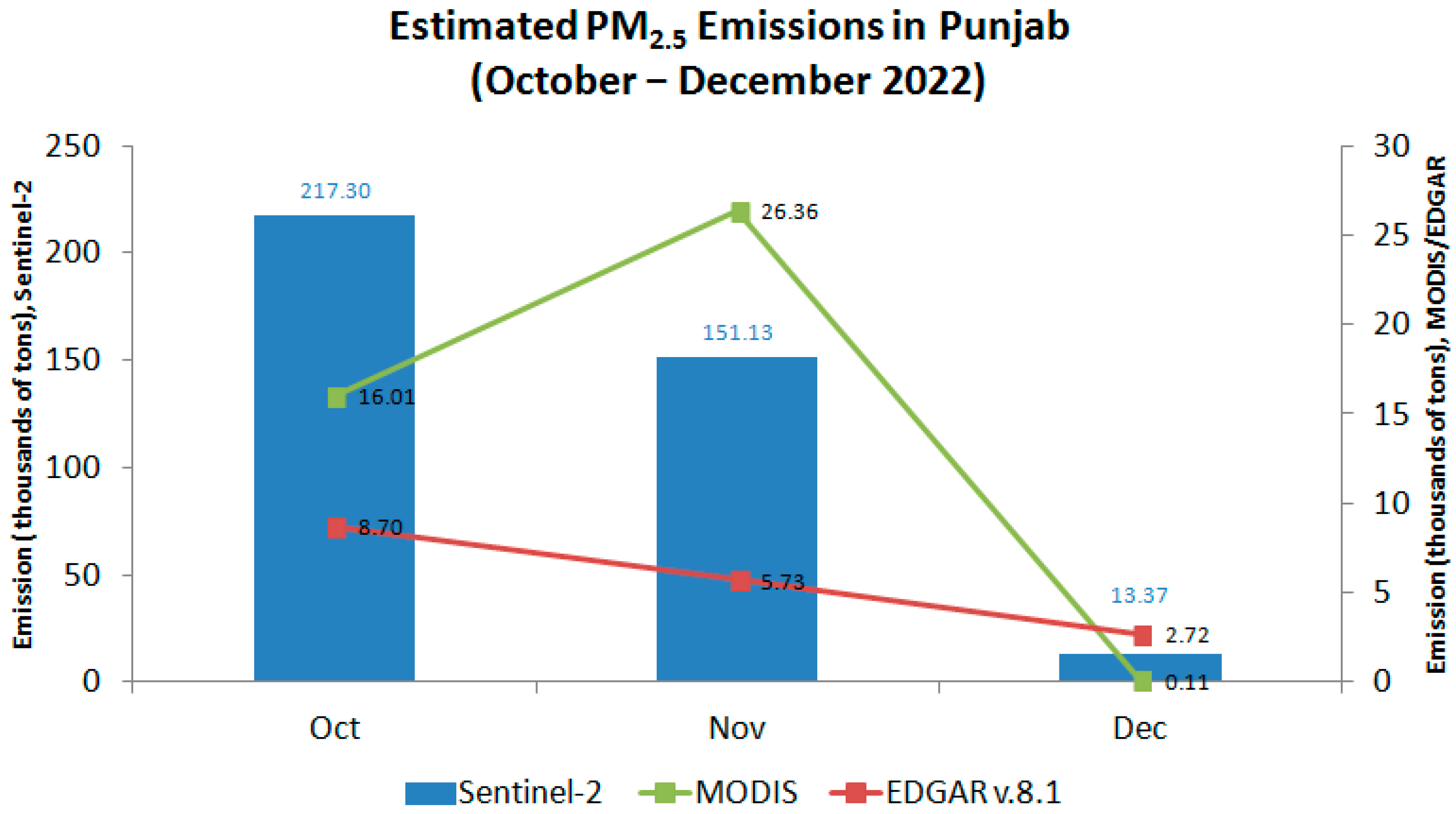Spatiotemporal Variation of Burnt Area Detected from High-Resolution Sentinel-2 Observation During the Post-Monsoon Fire Seasons of 2022–2024 in Punjab, India
Abstract
Highlights
- High-resolution Sentinel-2 observation captures spatiotemporal variability of the fine-scale burnt areas in Punjab, which are often missed by coarser-resolution observation modes such as MODIS.
- PM2.5 emissions derived from Sentinel-2 observation are much higher than those reported by the EDGAR v.8.1 global inventory.
- More accurate burnt area (BA) detection and PM2.5 emission estimation provide considerable improvement over coarse-resolution inventories to support better air quality modeling and monitoring.
- The discrepancy in PM2.5 emission estimation underscores the need for observation-driven monitoring systems, rather than the conventional statistics, to support the fire mitigation strategy and to strengthen policy responses to seasonal biomass burning.
Abstract
1. Introduction
2. Materials and Methods
2.1. Area of Interest
2.2. Data
2.3. Identification of Burnt Areas
2.3.1. Sentinel-2 dNBR
2.3.2. MODIS Fire Hotspot
2.4. Estimated PM2.5 Emissions
3. Results
3.1. Burnt Area Detection from Sentinel-2
3.2. Ground Validation
3.3. Comparison with MODIS Burnt Area Products
3.4. Estimated PM2.5 Emissions from Sentinel-2Derived Burnt Areas
4. Discussion
5. Conclusions
Author Contributions
Funding
Institutional Review Board Statement
Informed Consent Statement
Data Availability Statement
Acknowledgments
Conflicts of Interest
Abbreviations
| PM | Particulate Matter |
| NDVI | Normalized Difference Vegetation Index |
| NDWI | Normalized Difference Water Index |
| NBR | Normalized Burn Ratio |
| dNBR | Delta Normalized Burn Ratio |
| MODIS | Moderate Resolution Imaging Spectrometer |
| VIIRS | Visible Infrared Imaging Radiometer Suite |
| FHS | Fire Hotspot |
| BA | Burnt Area |
| GEE | Google Earth Engine |
| S2 SR | Sentinel-2 Surface Reflectance |
| SCL | Scene Classification Layer |
| EDGAR | Emissions Database for Global Atmospheric Research |
| AD | Activity Data |
| NIR | Near-Infrared |
| SWIR | Short Wave Infrared |
| EF | Emission Factor |
| AOI | Area of Interest |
References
- Abdurrahman, M.I.; Chaki, S.; Saini, G. Stubble burning: Effects on health & environment, regulations and management practices. Environ. Adv. 2020, 2, 100011. [Google Scholar] [CrossRef]
- Kumar, P.; Kumar, S.; Joshi, L. Socioeconomic and Environmental Implications of Agricultural Residue Burning; Springer: Berlin, Germany, 2015; ISBN 9788132221463. [Google Scholar]
- Jethva, H.; Torres, O.; Field, R.D.; Lyapustin, A.; Gautam, R.; Kayetha, V. Connecting Crop Productivity, Residue Fires, and Air Quality over Northern India. Sci. Rep. 2019, 9, 16594. [Google Scholar] [CrossRef]
- IQAir. 2019 World Air Quality Report; IQAir: Steinach, Switzerland, 2019; pp. 1–35. [Google Scholar]
- Balakrishnan, K.; Dey, S.; Gupta, T.; Dhaliwal, R.S.; Brauer, M.; Cohen, A.J.; Stanaway, J.D.; Beig, G.; Joshi, T.K.; Aggarwal, A.N.; et al. The impact of air pollution on deaths, disease burden, and life expectancy across the states of India: The Global Burden of Disease Study 2017. Lancet. Planet. Health 2019, 3, e26–e39. [Google Scholar] [CrossRef] [PubMed]
- Singh, T.; Matsumi, Y.; Nakayama, T.; Hayashida, S.; Patra, P.K.; Yasutomi, N.; Kajino, M.; Yamaji, K.; Khatri, P.; Takigawa, M.; et al. Very high particulate pollution over northwest India captured by a high-density in situ sensor network. Sci. Rep. 2023, 13, 13201. [Google Scholar] [CrossRef] [PubMed]
- Murphy, K.A.; Reynolds, J.H.; Koltun, J.M. Evaluating the ability of the differenced Normalized Burn Ratio (dNBR) to predict ecologically significant burn severity in Alaskan boreal forests. Int. J. Wildland Fire 2008, 17, 490–499. [Google Scholar] [CrossRef]
- Escuin, S.; Navarro, R.; Fernández, P. Fire severity assessment by using NBR (Normalized Burn Ratio) and NDVI (Normalized Difference Vegetation Index) derived from LANDSAT TM/ETM images. Int. J. Remote Sens. 2008, 29, 1053–1073. [Google Scholar] [CrossRef]
- Pradhan, S. Crop area estimation using GIS, remote sensing and area frame sampling. Int. J. Appl. Earth Obs. Geoinf. 2001, 3, 86–92. [Google Scholar] [CrossRef]
- Chuvieco, E.; Martín, M.P.; Palacios, A. Assessment of different spectral indices in the red-near-infrared spectral domain for burned land discrimination. Int. J. Remote Sens. 2002, 23, 5103–5110. [Google Scholar] [CrossRef]
- Xia, N.; Cheng, L.; Li, M.C. Mapping urban areas using a combination of remote sensing and geolocation data. Remote Sens. 2019, 11, 1470. [Google Scholar] [CrossRef]
- Wellmann, T.; Lausch, A.; Andersson, E.; Knapp, S.; Cortinovis, C.; Jache, J.; Scheuer, S.; Kremer, P.; Mascarenhas, A.; Kraemer, R.; et al. Remote sensing in urban planning: Contributions towards ecologically sound policies? Landsc. Urban Plan. 2020, 204, 103921. [Google Scholar] [CrossRef]
- Dos Santos, S.M.B.; Bento-Gonçalves, A.; Vieira, A. Research on wildfires and remote sensing in the last three decades: A bibliometric analysis. Forests 2021, 12, 604. [Google Scholar] [CrossRef]
- Thies, B.; Bendix, J. Satellite based remote sensing of weather and climate: Recent achievements and future perspectives. Meteorol. Appl. 2011, 18, 262–295. [Google Scholar] [CrossRef]
- You, Y.; Cao, J.; Zhou, W. A survey of change detection methods based on remote sensing images for multi-source and multi-objective scenarios. Remote Sens. 2020, 12, 2460. [Google Scholar] [CrossRef]
- Ziemann, A.; Ren, C.X.; Theiler, J. Multi-sensor anomalous change detection in remote sensing imagery. J. Appl. Remote Sens. 2021, 15, 042411. [Google Scholar] [CrossRef]
- Yohannes, H.; Soromessa, T.; Argaw, M.; Dewan, A. Impact of landscape pattern changes on hydrological ecosystem services in the Beressa watershed of the Blue Nile Basin in Ethiopia. Sci. Total Environ. 2021, 793, 148559. [Google Scholar] [CrossRef]
- Chowdhury, E.H.; Hassan, Q.K. Operational perspective of remote sensing-based forest fire danger forecasting systems. ISPRS J. Photogramm. Remote Sens. 2015, 104, 224–236. [Google Scholar] [CrossRef]
- Abdollahi, M.; Islam, T.; Gupta, A.; Hassan, Q.K. An advanced forest fire danger forecasting system: Integration of remote sensing and historical sources of ignition data. Remote Sens. 2018, 10, 923. [Google Scholar] [CrossRef]
- Jain, R.; Saboo, S.; Techkchandani, A. Crop Stubble Burning: Can modern technology trigger a new revolution? In Proceedings of the 2021 Innovations in Energy Management and Renewable Resources (IEMRE), Kolkata, India, 5–7 February 2021. [Google Scholar] [CrossRef]
- Sharma, A.; Kumar, H.; Mittal, K.; Kauhsal, S.; Kaushal, M.; Gupta, D.; Narula, A. IoT and deep learning-inspired multi-model framework for monitoring Active Fire Locations in Agricultural Activities. Comput. Electr. Eng. 2021, 93, 107216. [Google Scholar] [CrossRef]
- Vadrevu, K.P.; Ellicott, E.; Badarinath, K.V.S.; Vermote, E. MODIS derived fire characteristics and aerosol optical depth variations during the agricultural residue burning season, north India. Environ. Pollut. 2011, 159, 1560–1569. [Google Scholar] [CrossRef]
- Smith, R.; Adams, M.; Maier, S.; Craig, R.; Kristina, A.; Maling, I. Estimating the area of stubble burning from the number of active fires detected by satellite. Remote Sens. Environ. 2007, 109, 95–106. [Google Scholar] [CrossRef]
- Liu, T.; Mickley, L.J.; Marlier, M.E.; DeFries, R.S.; Khan, M.F.; Latif, M.T.; Karambelas, A. Diagnosing spatial biases and uncertainties in global fire emissions inventories: Indonesia as regional case study. Remote Sens. Environ. 2020, 237, 111557. [Google Scholar] [CrossRef]
- Ramo, R.; Roteta, E.; Bistinas, I.; van Wees, D.; Bastarrika, A.; Chuvieco, E.; van der Werf, G.R. African burned area and fire carbon emissions are strongly impacted by small fires undetected by coarse resolution satellite data. Proc. Natl. Acad. Sci. USA 2021, 118, e2011160118. [Google Scholar] [CrossRef]
- Drusch, M.; Del Bello, U.; Carlier, S.; Colin, O.; Fernandez, V.; Gascon, F.; Hoersch, B.; Isola, C.; Laberinti, P.; Martimort, P.; et al. Sentinel-2: ESA’s Optical High-Resolution Mission for GMES Operational Services. Remote Sens. Environ. 2012, 120, 25–36. [Google Scholar] [CrossRef]
- Badarinath, K.V.S.; Kiran Chand, T.R.; Krishna Prasad, V. Agriculture crop residue burning in the Indo-Gangetic Plains—A study using IRS-P6 AWiFS satellite data. Curr. Sci. 2006, 91, 1085–1089. [Google Scholar]
- Chawala, P.; Sandhu, H.A.S. Stubble burn area estimation and its impact on ambient air quality of Patiala & Ludhiana district, Punjab, India. Heliyon 2020, 6, e03095. [Google Scholar] [CrossRef]
- Singh, G.; Kant, Y.; Dadhwal, V.K. Remote sensing of crop residue burning in Punjab (India): A study on burned area estimation using multi-sensor approach. Geocarto Int. 2009, 24, 273–292. [Google Scholar] [CrossRef]
- Kumar, R.; Kaur, N. Spatial Patterns of Stubble Burning during Kharif Season: A Geographical Analysis of Punjab. Indian J. Sustain. Dev. 2023, 9, 29–42. [Google Scholar]
- Anand, A.; Imasu, R.; Dhaka, S.K.; Patra, P.K. Domain Adaptation and Fine-Tuning of a Deep Learning Segmentation Model of Small Agricultural Burn Area Detection Using High-Resolution Sentinel-2 Observations: A Case Study of Punjab, India. Remote Sens. 2025, 17, 974. [Google Scholar] [CrossRef]
- Key, C.H.; Benson, N.C. Landscape Assessment (LA) Sampling and Analysis Methods; USDA Forest Service General Technical Reports RMRS-GTR; USDA: Colorado, CO, USA, 2006.
- Gorelick, N.; Hancher, M.; Dixon, M.; Ilyushchenko, S.; Thau, D.; Moore, R. Google Earth Engine: Planetary-scale geospatial analysis for everyone. Remote Sens. Environ. 2017, 202, 18–27. [Google Scholar] [CrossRef]
- Punia, M.; Nautiyal, V.P.; Kant, Y. Identifying biomass burned patches of agriculture residue using satellite remote sensing data. Curr. Sci. 2008, 94, 1185–1190. [Google Scholar]
- Ahmed, T.; Ahmad, B.; Ahmad, W. Why do farmers burn rice residue? Examining farmers’ choices in Punjab, Pakistan. Land Use Policy 2015, 47, 448–458. [Google Scholar] [CrossRef]
- Keil, A.; Krishnapriya, P.P.; Mitra, A.; Jat, M.L.; Sidhu, H.S.; Krishna, V.V.; Shyamsundar, P. Changing agricultural stubble burning practices in the Indo-Gangetic plains: Is the Happy Seeder a profitable alternative? Int. J. Agric. Sustain. 2020, 19, 128–151. [Google Scholar] [CrossRef]
- Bar, S.; Parida, B.R.; Pandey, A.C. Landsat-8 and Sentinel-2 based Forest fire burn area mapping using machine learning algorithms on GEE cloud platform over Uttarakhand, Western Himalaya. Remote Sens. Appl. Soc. Environ. 2020, 18, 100324. [Google Scholar] [CrossRef]
- Schepers, L.; Haest, B.; Veraverbeke, S.; Spanhove, T.; Borre, J.V.; Goossens, R. Burned area detection and burn severity assessment of a heathland fire in belgium using airborne imaging spectroscopy (APEX). Remote Sens. 2014, 6, 1803–1826. [Google Scholar] [CrossRef]
- Tanase, M.A.; Belenguer-Plomer, M.A.; Roteta, E.; Bastarrika, A.; Wheeler, J.; Fernández-Carrillo, Á.; Tansey, K.; Wiedemann, W.; Navratil, P.; Lohberger, S.; et al. Burned area detection and mapping: Intercomparison of Sentinel-1 and Sentinel-2 based algorithms over tropical Africa. Remote Sens. 2020, 12, 334. [Google Scholar] [CrossRef]
- Gadde, B.; Bonnet, S.; Menke, C.; Garivait, S. Air pollutant emissions from rice straw open field burning in India, Thailand and the Philippines. Environ. Pollut. 2009, 157, 1554–1558. [Google Scholar] [CrossRef]
- Zhou, Y.; Xing, X.; Lang, J.; Chen, D.; Cheng, S.; Wei, L.; Wei, X.; Liu, C. A comprehensive biomass burning emission inventory with high spatial and temporal resolution in China. Atmos. Chem. Phys. 2017, 17, 2839–2864. [Google Scholar] [CrossRef]
- Akagi, S.K.; Yokelson, R.J.; Wiedinmyer, C.; Alvarado, M.J.; Reid, J.S.; Karl, T.; Crounse, J.D.; Wennberg, P.O. Emission factors for open and domestic biomass burning for use in atmospheric models. Atmos. Chem. Phys. 2011, 11, 4039–4072. [Google Scholar] [CrossRef]
- Lasko, K.; Vadrevu, K. Improved rice residue burning emissions estimates: Accounting for practice-specific emission factors in air pollution assessments of Vietnam. Environ. Pollut. 2018, 236, 795–806. [Google Scholar] [CrossRef] [PubMed]
- Kumar, P.; Rajpoot, S.K.; Jain, V.; Saxena, S.; Neetu; Ray, S.S. Monitoring of Rice Crop in Punjab and Haryana with Respect to Residue Burning. Int. Arch. Photogramm. Remote Sens. Spat. Inf. Sci. 2019, 42, 31–36. [Google Scholar] [CrossRef]
- Hantson, S.; Padilla, M.; Corti, D.; Chuvieco, E. Strengths and weaknesses of MODIS hotspots to characterize global fire occurrence. Remote Sens. Environ. 2013, 131, 152–159. [Google Scholar] [CrossRef]
- Giglio, L.; Descloitres, J.; Justice, C.O.; Kaufman, Y.J. An enhanced contextual fire detection algorithm for MODIS. Remote Sens. Environ. 2003, 87, 273–282. [Google Scholar] [CrossRef]
- Giglio, L.; Schroeder, W.; Justice, C.O. The collection 6 MODIS active fire detection algorithm and fire products. Remote Sens. Environ. 2016, 178, 31–41. [Google Scholar] [CrossRef]
- Dozier, J. Satellite Identification of Surface Radiant Temperature Fields of Subpixel Resolution (Planck Function); NOAA Technical Memorandum NESS 113; NOAA: Washington, DC, USA, 1980; p. 229.
- Matson, M.; Dozier, J. Identification of subresolution high temperature sources using a thermal IR sensor. Photogramm. Eng. Remote Sens. 1981, 47, 1311–1318. [Google Scholar]
- Giglio, L. MODIS Collection 4 Active Fire Product User ’ s Guide Table of Contents. Revisión, B. Nasa 2018, 1, 64. [Google Scholar]
- Solazzo, E.; Crippa, M.; Guizzardi, D.; Muntean, M.; Choulga, M.; Janssens-Maenhout, G. Uncertainties in the Emissions Database for Global Atmospheric Research (EDGAR) emission inventory of greenhouse gases. Atmos. Chem. Phys. 2021, 21, 5655–5683. [Google Scholar] [CrossRef]
- Yevich, R.; Logan, J.A. An assessment of biofuel use and burning of agricultural waste in the developing world. Glob. Biogeochem. Cycles 2003, 17, 1095. [Google Scholar] [CrossRef]
- Olivier, J. On the Quality of Global Emission Inventories: Approached, Methodologies and Uncertainty; Wilco BV: Amersfoort, The Netherlands, 2002; ISBN 90-393-3103-0. [Google Scholar]












| Severity Level | dNBR Range (Scaled by 103) |
|---|---|
| Unburnt | Less than 100 |
| Low severity | +100–+269 |
| Moderate severity (low) | +270–+439 |
| Moderate severity (high) | +440–+659 |
| High severity | +660–+1300 |
| Burning Efficiency | Emission Factor (g kg−1) | PM2.5 Emission (Thousand Tons) |
|---|---|---|
| 0.5 | 0.0042 | 44.84 |
| 0.5 | 0.0091 | 97.14 |
| 0.5 | 0.0207 | 220.97 |
| 0.8 | 0.0042 | 71.74 |
| 0.8 | 0.0091 | 155.43 |
| 0.8 | 0.0207 | 353.56 |
| 0.9 | 0.0042 | 80.70 |
| 0.9 | 0.0091 | 174.86 |
| 0.9 | 0.0207 | 397.75 |
Disclaimer/Publisher’s Note: The statements, opinions and data contained in all publications are solely those of the individual author(s) and contributor(s) and not of MDPI and/or the editor(s). MDPI and/or the editor(s) disclaim responsibility for any injury to people or property resulting from any ideas, methods, instructions or products referred to in the content. |
© 2025 by the authors. Licensee MDPI, Basel, Switzerland. This article is an open access article distributed under the terms and conditions of the Creative Commons Attribution (CC BY) license (https://creativecommons.org/licenses/by/4.0/).
Share and Cite
Arbain, A.A.; Imasu, R. Spatiotemporal Variation of Burnt Area Detected from High-Resolution Sentinel-2 Observation During the Post-Monsoon Fire Seasons of 2022–2024 in Punjab, India. Sensors 2025, 25, 5588. https://doi.org/10.3390/s25175588
Arbain AA, Imasu R. Spatiotemporal Variation of Burnt Area Detected from High-Resolution Sentinel-2 Observation During the Post-Monsoon Fire Seasons of 2022–2024 in Punjab, India. Sensors. 2025; 25(17):5588. https://doi.org/10.3390/s25175588
Chicago/Turabian StyleArbain, Ardhi Adhary, and Ryoichi Imasu. 2025. "Spatiotemporal Variation of Burnt Area Detected from High-Resolution Sentinel-2 Observation During the Post-Monsoon Fire Seasons of 2022–2024 in Punjab, India" Sensors 25, no. 17: 5588. https://doi.org/10.3390/s25175588
APA StyleArbain, A. A., & Imasu, R. (2025). Spatiotemporal Variation of Burnt Area Detected from High-Resolution Sentinel-2 Observation During the Post-Monsoon Fire Seasons of 2022–2024 in Punjab, India. Sensors, 25(17), 5588. https://doi.org/10.3390/s25175588






